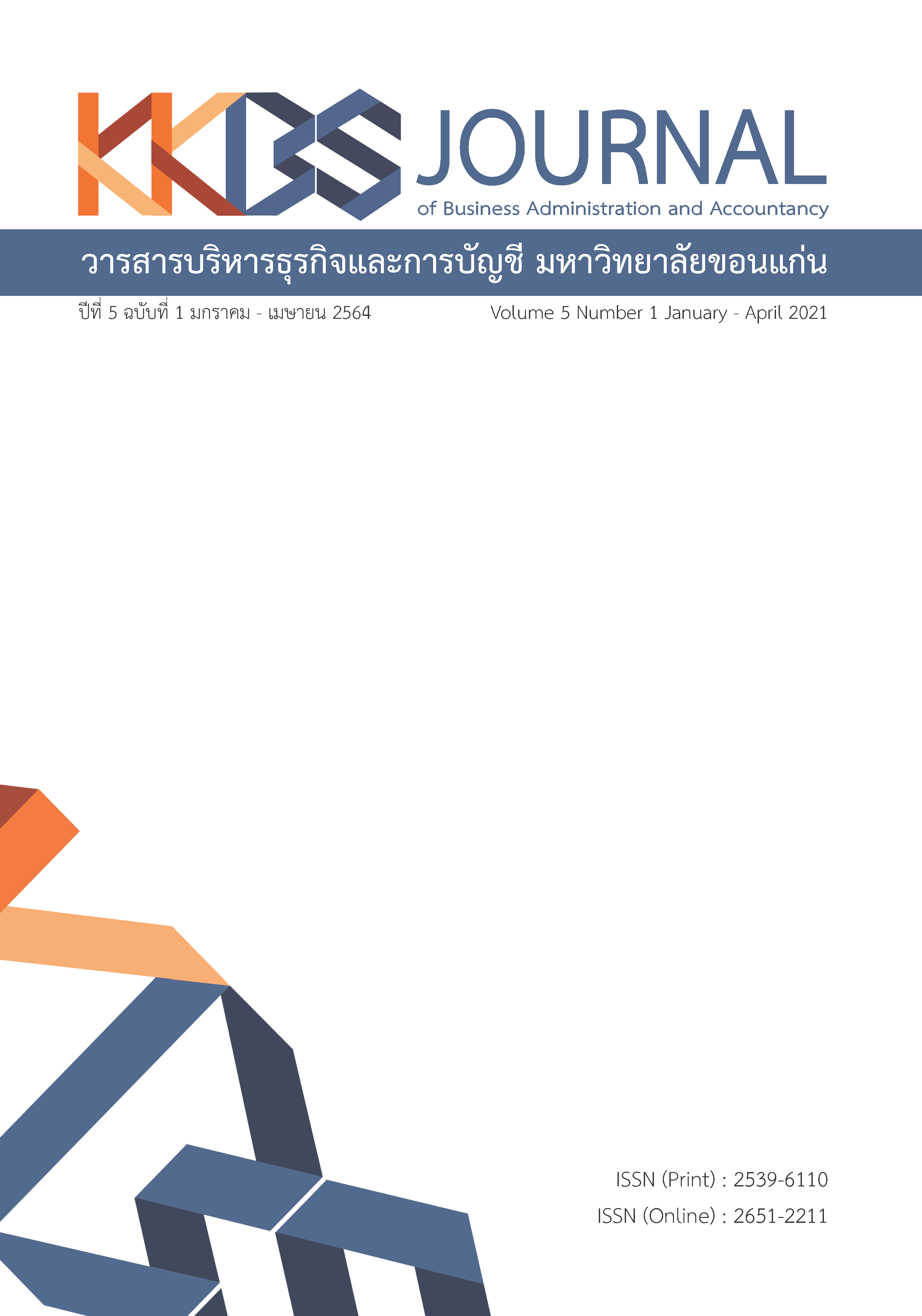การลดความสูญเปล่าในกระบวนการจัดเก็บสินค้าคงคลัง กรณีศึกษาธุรกิจผลิตและจำหน่ายประตูไม้ จังหวัดร้อยเอ็ด
Main Article Content
บทคัดย่อ
การเพิ่มอัตราการหมุนเวียนสินค้าคงเหลือมีความสำคัญต่อการลดต้นทุนการเก็บรักษาสินค้าคงคลัง โดยอาศัยวิธีการลดความสูญเปล่าที่ไม่ก่อให้เกิดคุณค่าในกระบวนการจัดเก็บสินค้าคงคลัง การวิจัยนี้จึงมีวัตถุประสงค์เพื่อศึกษาความสูญเปล่าและเพิ่มอัตราการหมุนเวียนสินค้าคงเหลือด้วยการลดความสูญเปล่าในกระบวนการจัดเก็บสินค้าคงคลัง โดยเก็บรวบรวมข้อมูลจากผู้ให้ข้อมูลหลักจำนวน 15 คน ด้วยการสังเกตแบบมีส่วนร่วม ร่วมกับการสัมภาษณ์เชิงลึกและการสนทนากลุ่ม โดยใช้การวิเคราะห์แผนผังกระบวนการ IDEF0 ร่วมกับการวิเคราะห์คุณค่ากิจกรรม ตลอดจนวัดอัตราการหมุนเวียนสินค้าคงเหลือและระยะเวลาขายสินค้าเฉลี่ย รวมถึงวิเคราะห์ต้นทุนการเก็บรักษาสินค้าคงคลัง เมื่อลดความสูญเปล่าในกระบวนการจัดเก็บสินค้าคงคลัง ผลการวิจัยพบว่าสามารถทำให้อัตราการหมุนเวียนสินค้าคงเหลือเพิ่มขึ้นจาก 0.57 เท่า เป็น 0.74 เท่า ขณะที่ระยะเวลาขายสินค้าเฉลี่ยลดจาก 635 วัน เป็น 493 วัน ส่งผลให้ต้นทุนการเก็บรักษาสินค้าคงคลังลดลงจาก 2,754,585 บาท เป็น 2,007,715 บาท ผู้วิจัยจึงเสนอให้ผู้ประกอบการให้ความสำคัญต่อการลดสูญเปล่าในกระบวนการจัดเก็บสินค้าคงคลัง ด้วยแนวทางที่ไม่ซับซ้อนและสะดวกต่อการสื่อสารไปยังพนักงานให้รับทราบโดยทั่วกัน ทั้งการนำหลักการ ECRS เข้ามาปรับปรุงกระบวนการ การกำหนดมาตรฐานในการปฏิบัติงาน การนำเทคโนโลยีคอมพิวเตอร์เข้ามาประยุกต์ใช้ในการเก็บและประมวลข้อมูล เพื่อเพิ่มอัตราการหมุนเวียนสินค้าคงเหลือให้มีประสิทธิภาพ และลดต้นทุนในส่วนของการเก็บรักษาสินค้าคงคลัง ซึ่งเป็นประโยชน์ต่อการดำเนินงานของธุรกิจผลิตและจำหน่ายประตูไม้ได้ต่อไป
Article Details
บทความที่ได้รับการตีพิมพ์ในวารสารเป็นความคิดเห็นของผู้เขียน มิใช่ความคิดเห็นของกองบรรณาธิการและคณะผู้จัดทำวารสาร และบทความที่ได้รับการตีพิมพ์เป็นลิขสิทธิ์ของวารสารบริหารธุรกิจและการบัญชี มหาวิทยาลัยขอนแก่น
References
Akkucuk, U. (2019). The circular economy and Its implications on sustainability and the green supply chain. Hershey, PA.: IGI Global.
Buede, D.M. & Miller, W.D. (2016). The engineering design of systems: Models and methods. 3rd ed. Hoboken, NJ.: Wiley.
Farooq, U. (2019). Impact of inventory turnover on the profitability of non-financial sector firms in Pakistan. Journal of Finance and Accounting Research, 1(1), 34-51.
Hair, J.F. et al. (2019). Multivariate data analysis. 7th ed. Upper Saddle River, NJ.: Prentice Hall.
Hançerlioğulları, G., Şen, A. & Aktunç, E.A. (2016). Demand uncertainty and inventory turnover performance: An empirical analysis of the US retail industry. International Journal of Physical Distribution & Logistics Management, 46(6-7), 681-708.
Kerber, B. & Dreckshage, B.J. (2017). Lean supply chain management essentials: A framework for materials managers. Boca Raton: CRC Press.
Khan, J.A., Deng, S. & Khan, M.H.A. (2016). An Empirical analysis of inventory turnover performance within a Local Chinese supermarket. European Scientific Journal, 12(34), 145-157.
Khunthawi Wooden Production Accounting Section. (2020). Inventory account report 2019. Roi Et: Khunthawi Wooden Production. (In Thai)
Krogstie, J. (2016). Quality in business process modeling. Switzerland: Springer.
Ledbetter, P. (2018). The Toyota template: The plan for just-in-time and culture change beyond lean tools. Boca Raton: CRC Press.
Lin, R. (2019). The importance of successful inventory management to enterprises: A case study of Wal-Mart. In 2019 International Conference on Management, Finance and Social Sciences Research (MFSSR 2019). London: Francis Academic Press.
Myerson, P. (2012). Lean supply chain and logistics management. New York: McGraw-Hill.
Nakyam, N., Prasetsak, A & Rungnarai, A. (2020). The development of inventory management program for Chinese Banquet business in Nakhon Pathom Province. KKBS Journal of Business Administration and Accountancy, 4(1), 45-64. (In Thai)
Pinyopummin, C., Rinchumphu, D. & Arunotayanun, K. (2020). Inventory management in small construction business. The 25 th National Convention on Civil Engineering. Chonburi: NCCE. (In Thai)
Rao, M.C. & Rao, K.P. (2009). Inventory turnover ratio as a supply chain performance measure. Serbian Journal of Management, 4(1), 41-50.
Rich, J. & Jones, J.P. (2017). Cornerstones of financial accounting. 4th ed. Boston: Cengage Learning.
Ross, D.F. (2016). Distribution planning and control: managing in the era of supply chain management. 3rd ed. New York: Springer.
Sangster, A. & Wood, F. (2018). Frank wood's business accounting volume 2. 14th ed. Harlow: Pearson.
Sermpraphaslip, K. (2014). A study of furniture product warehouse process: A case study of SPS Intertech Co., Ltd. Chandrakasem Rajabhat University Journal, 20(39), 119-127. (In Thai)
Suhardi, B., Anisa, N. & Laksono, P.W. (2019). Minimizing waste using lean manufacturing and ECRS principle in Indonesian furniture industry. Cogent Engineering, 6(1), 1-13.
Surjandy, S. & Ratnasari, I. (2018). Decision table with inventory turnover ratio to solve operational and strategic issues. Journal of Information Systems Engineering and Business Intelligence, 2018, 4(1), 32-38.
Thaplaima, K. & Rattanawong, W. (2016). Optimization of production processes and warehousing company case studies, Idee Mobel limited. The 16th Thai Value Chain Management and Logistics Conference. Bangkok: UTCC. (In Thai)
Thompson, J. (2013). The lean office: How to use just-in-time techniques to streamline your office. Toronto: Productive Publications.
Vilasdechanon, S. & Sopadang, A. (2018). Business process reengineering for the saline management in hospitals. In 2018 5th International Conference on Industrial Engineering and Applications (ICIEA). Singapore: IEEE.

